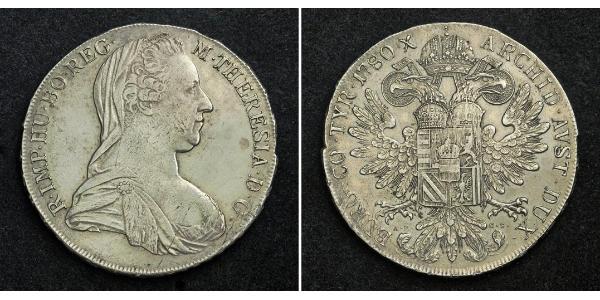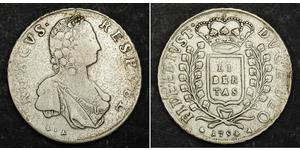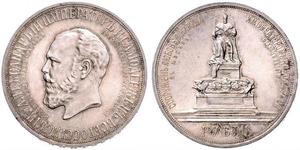(售价 $394.0)
1780, Empress Maria Theresa. Early Silver Thaler (AH-GS) Trade Coin. Karlsburg!
Mint Year: 1812-1820
Mint Place: Karlsburg (Transylvania)
Denomination: Silver "Maria Theresa" Thaler
Reference: KM-23, Leypold 22b, Hafner 3a. R!
Condition: Minimal scratches, otherwise a nice XF!
Mint Masters: A. J. Hammerschmidt / G. Schickmayer (A.H.-G.S.)
Weight: 27.98gm
Diameter: 40mm
Material: Silver
Obverse: Veiled and draped bust of Maria Theresia right, wearing perl-brooch. No mint master´s initials below!
Legend: M . THERESIA . D . G . R . IMP . HU BO . REG .
Reverse: Crown above double headed imperial eagle, large multiple coat of arms with three crowns and lion.
Legend: ARCHID . AVST . DUX . BURG . CO . TYR . 1780 . X
Comment: Mint master's initials of (A.H. - G.S.) below.
For your consideration a scarce example of the famous Maria Theresa Thaler, struck posthumously at the Karlsburg mint (Hungarian Transylvania, today's Romania) during 1812-1820. This is on of the earliest types and the 3rd variation listed in the Hafner Catalogue of Maria Theresa Thalers, which lacks the S.F. initials below Maria Theresa's bust and features the mint master's initals (AH-GS) below the eagle's claws. On later and restrike issues the S.F. initials were added, but the mint master's initials ommited. A must for every Austrian/Hungarian and Romanian coins collector and not a cheap recent re-strike.
Alba Iulia (Hungarian: Gyulafehérvár, Latin: Apulum, German: Karlsburg/Weißenburg, former Turkish: Erdel Belgradı) is a city in Alba County, Transylvania, Romania, located on the Mureş River. Between 1541 and 1690 it was the capital of the Principality of Transylvania. The city is historically important for both Romanians and Hungarians.
Maria Theresa (German: Maria Theresia, see also other languages; May 13, 1717 – November 29, 1780) was a reigning Archduchess of Austria, a Queen of Hungary and Bohemia, and a Holy Roman Empress.
Maria Theresa was the oldest daughter of Elisabeth Christine of Brunswick-Wolfenbüttel and Emperor Charles VI, who promulgated the Pragmatic Sanction to allow her to succeed to the Habsburg monarchy. Opposition to her acceding to the throne led to the War of the Austrian Succession in 1740. After Emperor Charles VII, who claimed the throne, died in 1745, Maria Theresa obtained the imperial crown for her husband, Francis I. Though she was technically empress consort, Maria Theresa was the de facto ruler of the nation, and she began styling herself Holy Roman Empress in 1745. Maria Theresa had in fact already begun her rule in 1740 during the Austrian War of Succession.
Maria Theresa helped initiate financial and educational reforms, promoted commerce and the development of agriculture, and reorganized the army, all of which strengthened Austria's resources. Continued conflict with the Kingdom of Prussia led to the Seven Years' War and later to the War of the Bavarian Succession. She became dowager empress after the death of Francis and ascession of her son Joseph as emperor in 1765. Maria Theresa criticized many of Joseph's actions but agreed to the First Partition of Poland (1772). A key figure in the power politics of 18th century Europe, Maria Theresa brought unity to the Habsburg Monarchy and was considered one of its most capable rulers. Her 16 children also included Marie Antoinette, queen consort of France, and Leopold II, Holy Roman Emperor.
1 Ruble 俄罗斯帝国 (1721 - 1917) 銀
本组有 12 钱币 / 12 售价
⇑
















-300-150-72sKbzbis7EAAAFPBUQ1Mk0C.jpg)







